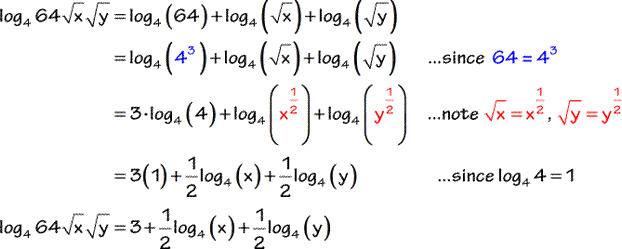

The most crucial part is to be well versed with squares, cubes, and roots of numbers. Solving a logarithm without a calculation is easier than it might seem. In the exponential form, this is equivalent to 2z = 321/2 This can be rewritten as log 2 (32)1/2 = z Let us convert it to exponential form (3/2)z = (27/8) This equation is not as difficult as it may seem.

We know that 121 is 11 squared, and hence the square root of 121 is 11. To find z, first let us convert this to exponential form: 121z = 11

Here 64 needs to be converted to (1/4) raised to an exponent, which is the solution to the logarithm. Now let us try to find z, by simplifying the equation This can be written in another form as: 4z = 1/64 Let us consider that log 4 (1/64) equals to z Some logarithms are more complicated but can still be solved without a calculator. In such cases, it is understood that the base value by default is 10. It is to be noted that in some instances you might notice that the base is not mentioned. One the base and the number in the parenthesis are identical, the exponent of the number is the solution to the logarithm. Let us try to replace the number in the parenthesis with the base raised to an exponent. Let us use an example to understand this further: log 5 (25) Remembering and understanding this equivalency is the key to solving logarithmic problems. Here log x (y) is known as the logarithmic form, and xz = y is known as the exponential form. In other words, x needs to be raised to the power z to produce y. If xz = y, then ‘z’ is the answer to the log of y with base x, i.e., log x (y) = z The solution of any logarithm is the power or exponent to which the base must be raised to reach the number mentioned in the parenthesis. We first need to understand square, cubes, and roots of a number.
#Condense logs calculator how to
Now, let’s get to the main part: How to Solve a Log Without Using a Calculator? The number that needs to be raised is called the base. Defining a logarithm or logĪ logarithm is defined as the power or exponent to which a number must be raised to derive a certain number. To solve a logarithm without a calculator, let us first understand what a logarithm is.

Natural logs are usually represented by ln.Logarithms are an integral part of the calculus. e is a mathematical constant and is approximately equal to 2.718. Natural Logarithmic Functions: Such types of logs have the base e. If the logarithm does not have a base, we can assume it to be 10. Usually, such logs do not have 10 written as their base.ġ0 2 = 100 \(\) log 100 = 2 They are:Ĭommon Logarithmic Functions: When logarithmic functions have a base of 10 they are known as common logarithmic functions. There are different categories of logarithmic functions depending upon the value of the base. a is known as the argument while b is the base. Now if we convert this equation by using the log notation, we getĪ, b and x are positive real numbers. The value of this expression is given by a. In exponential form, this can be written as follows We can say that the logarithm of a number (say a) is the exponent or power to which a base (say b) must be raised in order to get the number itself.


 0 kommentar(er)
0 kommentar(er)
